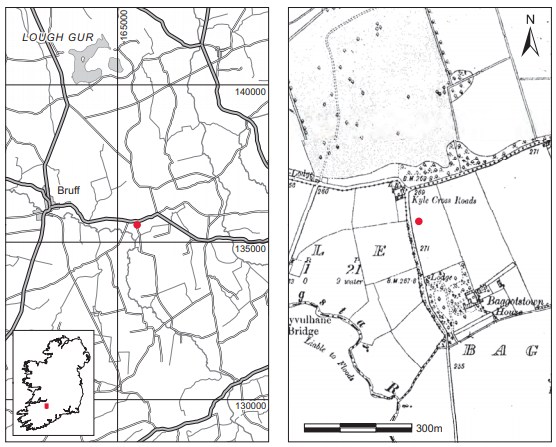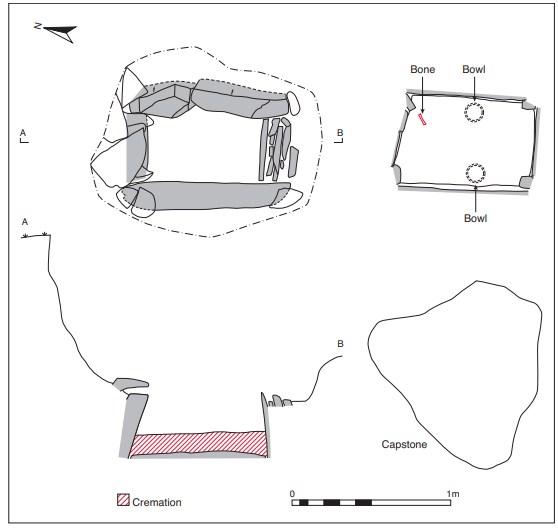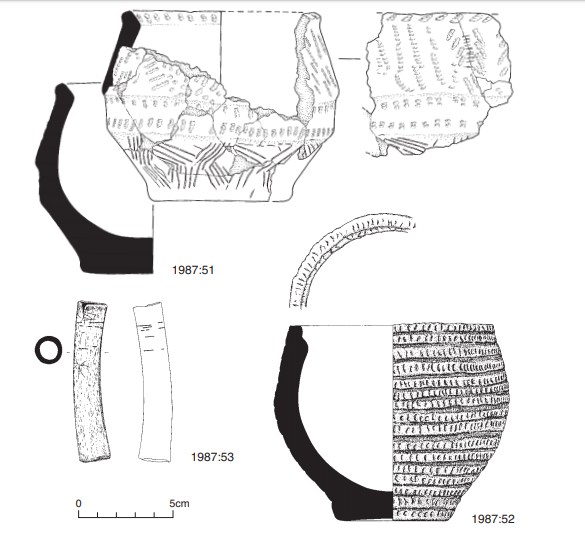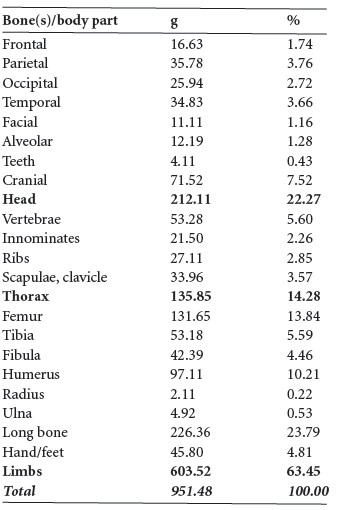County: Limerick Site name: BAGGOTSTOWN, CO. LIMERICK
Sites and Monuments Record No.: SMR LI040:010 Licence number: E1109
Author: RAGHNALL Ó FLOINN
Site type: Early Bronze Age graves
Period/Dating: —
ITM: E 565582m, N 635607m
Latitude, Longitude (decimal degrees): 52.470814, -8.506560
Introduction
In May 1987, a short cist containing cremated bone, two bowls and a bone object was discovered during the bulldozing of a mound at Baggotstown, near Bruff, Co. Limerick. The site was found near the centre of the mound when the capstones of the cist were struck by the machine. Both vessels had been removed from the cist by Mr J. Crowe, who then reported the find to the NMI. A rescue excavation was undertaken by Raghnall Ó Floinn. The human remains from the site were analysed by Barra Ó Donnabháin.’
Location (Fig. 3.94)
The site was in the townland of Baggotstown, approximately 2km east of Bruff, east Co. Limerick.160 The mound was located along the west side of a field, and the field fence curves slightly around the western edge of the mound. It lay in flat ground at an altitude of 70–80m above sea level. The site is not marked on any of the Ordnance Survey maps, nor is it mentioned in M.J. O’Kelly’s (1941) survey of the barony of Small County.
Description of site
The cist was in the centre of the mound, which measured c. 1m high by 10m in diameter and had clearly been dug into the old ground level (Fig. 3.95). Approximately half of the mound

(the southern half) had been removed in the bulldozing. Hollow spaces between the boulders above and to the west of the cist and a protruding flagstone at least 0.7m long by 0.1m thick suggested the possibility of a second cist set in the body of the mound, but the area was not investigated at this time.
The cist was rectangular in plan, with its long axis aligned approximately north/south. It measured 0.85m long by 0.6m wide by 0.4m deep internally at floor level. It had originally been formed of four main edge-set slabs, but the eastern side stone had been badly shattered by the disturbance and the southern end stone had split, perhaps in antiquity, owing to the pressure of the capstone. The slabs would originally have been substantial in size, the western side stone measuring 1.01m long by 0.18m thick by approximately 0.4m high. The end slabs had been set between the ends of the long sides and these now inclined inwards. A number of small stones had been wedged in the spaces between the end and side stones and also between the capstone and the side stones. All of the cist slabs were limestone of local provenance. The floor of the cist was formed of a rectangular flagstone measuring 0.78m by 0.55m, which fitted against the sides except along the west, where there was a gap of 0.02–0.03m. The cist was covered by two capstones, one on top of the other. Only one of these remained on site at the time of excavation; this was roughly triangular in outline and measured 1.15m long by 1.06m wide.
The cist contained the cremated remains of an adult male and a juvenile (1987:50), two bowls and a polished bone cylinder. Two fragments of animal bone and an animal tooth, probably that of a cow, were found among the cremation. Soil and sods had clearly slipped into it on discovery. On removal, it appeared that a deposit of cremated bone had been spread out on the floor of the cist. At its centre it measured 0.12m thick but was spread into the

corners of the cist and into the gap between the floor and the western side stone. According to Mr Crowe, the intact bowl was found standing upright about midway along the eastern side of the cist. The damaged vessel had been placed halfway along the western side of the cist. Its lower half was found crushed but in situ, and this confirmed that the bowl had been set directly on the floor of the cist in an upright position. In the north-eastern corner of the cist, a polished bone cylinder 8.5cm long with knife-cut ends was found resting on some cremated bone. This has been identified as a femur of a sheep or goat. A small quantity of charcoal was mixed through the deposit and the undisturbed cist fill was collected for sieving. Small patches of grey sand occurred under the lowermost bones and perhaps represent the original fill placed with the bones. Small bones of a rodent were found on the floor of the cist close to the northern side stone, and mixed through the fill along the eastern side of the cist were small mollusc shells.
Pottery
Tripartite bowl, 1987:51 (Fig. 3.96)
This bowl survives in a fragmentary condition and portions of the rim and body are missing. It has a tripartite profile with a pair of horizontal ribs at the centre. The rim is internally bevelled. The body decoration is divided into three horizontal bands. The upper body has an impressed design made with a four- or five-pronged instrument with zones of diagonal and vertical impressions.

The central band contains two horizontal rows of impressions made with a two-pronged instrument impressed vertically. The lower band consists of a row of conjoined incised lozenges, each lozenge consisting of five or six concentrically arranged lines. The external rim bevel is decorated with diagonal impressions made with a two-pronged instrument and the internal rim bevel is decorated with similar impressions, vertically arranged.
Dimensions: H 9.5cm; max. ext. D rim 13cm; int. D rim 9cm; D base 6.8cm; T base 1.8cm.
Ribbed bowl, 1987:52 (Fig. 3.96)
This vessel is complete; it is high-shouldered with a rounded body and slightly concave neck. The rim has an internal bevel with a second band below. The vessel is decorated all over with incised ornament. The body is divided into sixteen horizontal bands by incised lines, each decorated with stab-marks either vertically or at a slight angle. Incised lines occur arranged radially on the rim bevel, while those on the lower bevel are set at an angle. The base is plain.
Dimensions: H 10cm; D base 6cm; ext. D rim 10.5cm; max. D 12cm.
Polished bone cylinder, 1987:53 (Fig. 3.96)
A fragment of an unburnt, polished and worked femur of sheep or goat. The ends are cut and the edges bevelled. A notch has been cut in the centre of one end. To one side are a series of cut lines forming an irregular pattern (one line runs parallel to the side of the notch, with a series of fine lines of unequal length running from it to one side). There are traces of three similar lines on the other side. In the centre of the same face are a number of scratched lines arranged in a rough star shape. Other scratch marks are also visible elsewhere on the surface.
Dimensions: max. L 8.42cm; max. ext. D 1.62cm
Comment
A sample of the cremation from the cist yielded a date of 3495±40 BP, which calibrates ton1923–1695 BC.161 Brindley (2007, 248) places both vessels in stage 3 of the bowl typology, which is dated to 1980–1930/20 BC. The unusual decorated bone tube cannot be paralleled and its function is not clear.
It is not clear whether or not the mollusc shells noted by the excavator were primary, although the presence of shells of different types has been noted in other cists, e.g. cowrie shells at Carrigeens, Co. Sligo (this volume, pp 435–49), and mussel shells in Annaghkeen, Co. Galway (this volume, pp 194–9). The fragments of animal bone and an animal tooth found in the cremation appear to be part of the primary fill of the cist and may represent, either actually or symbolically, the final meal of the deceased or sustenance for their final Journey.
HUMAN REMAINS
BARRA Ó DONNABHÁIN
Introduction
A relatively large collection—655.83g—of burnt human bone (1987:50) was recovered from the cist. Two individuals are represented in the deposit: a middle-aged adult male and a child of 8–9 years. During the excavation the cist was divided into four quadrants and the material from each of the quadrants was kept separately. A preliminary examination showed that the remains of both individuals were recovered from each of the quadrants; subsequently the deposit was analysed as a single unit. The average fragment size is 30–35mm, although the longest piece of bone recovered—a portion of the shaft of the fibula—has a maximum length of 135.5mm. All of the remains are calcined and the remains of both individuals have the warping, checking and cracking that are characteristic of fleshed bodies burnt at high temperatures. The remains of the child are more grossly warped than those of the adult. A relatively large quantity (73.58g) of ‘clinker’ was recovered with the bones. This has been described by Wells (1960), who postulated that this material was the remains of burnt flesh and hair. Two fragments of animal bone and an animal’s tooth were recovered from the cist. The tooth appears to belong to a large ungulate such as a cow.
Adult
The majority of the bone fragments belong to the adult individual. Table 3.43 shows the weights of the fragments recovered from each of the major bones and body parts. All body parts are represented, though there appears to be a slight overrepresentation of long bone fragments. These tend to be the largest remaining after a cremation episode, so their preponderance may reflect a collection bias that favoured larger pieces of bone. Despite this, retrieval must have been relatively meticulous, as many of the smaller skeletal elements such as phalanges, tarsals and carpals were recovered.
Age and sex
The shape of the mastoid processes of the temporals and the supraorbital ridges of the frontal along with the general rugosity of the remains suggest that this was a male. Fortunately, the age-diagnostic pubic symphyses are intact. These suggest that this was a younger or middle adult. The convolutions of the endocranial sutures may suggest that the age at death was towards the latter end of this range.
Teeth
The presence of unhealed tooth sockets shows that the following teeth were present at the time of death:

Some loose teeth were also recovered. One of these, an upper first or second molar, has a caries cavity on the mesial aspect in the region of the cementum enamel junction. The only other anomaly encountered in the remains of the adult was a Poirier’s facet on an unsided portion of femur head. This is a normal variation in skeletal architecture.
Table 3.43—Weights and percentages of identified adult bone fragments, 1987:50.

Child
Of the 1,582 fragments of bone recovered from the cist, 167 were identifiable as belonging to the skeleton of a child. Table 3.44 shows the weights of the fragments from the major body parts of this individual. It is clear from this that a collection bias has favoured the recovery of fragments of the cranial skeleton.
Teeth
The following teeth were present at the time of death:

The state of development of the dentition suggests that this child was aged about 8–9 years at the time of death.
Pathology
The only pathological change encountered in the remains of the child was a mild degree of cribra orbitalia. This occurs on the right orbital plate of the frontal. The left side was not recovered and so was not available for inspection. Cribra orbitalia is a condition of unknown aetiology but current thinking favours iron-deficiency anaemia or nutritional deficiency as causative factors.
Table 3.44—Weights and percentages of identified juvenile bone fragments, 1987:50.

Conclusions
The deposit recovered from the cist contained the burnt remains of a robust, probably younger or middle adult male and an 8–9-year-old child. The presence of a number of individuals in one cremation deposit is not unusual and the combination of the remains of an adult and child is also quite common (e.g. Ó Donnabháin 1985). The remains of both individuals were efficiently burnt. The degree of warping observed in the bones of both individuals suggests that the bodies were placed under the pyre(s)—the warping being caused in part by the weight of pyre material. The remains of the juvenile are more grossly warped than those of the adult; this may indicate that the two individuals were burnt in separate cremation episodes. Either way, both corpses were completely incinerated. Competent cremations such as these are the norm in the Irish material of this date. The post-crematory retrieval of bones was also meticulous. Fragments of all body parts were recovered from both corpses and many of the smaller skeletal elements were collected. There were collection biases in favour of long bone fragments from the adult and cranial bone from the child. In the former case, this may simply have been due to the favouring of the larger fragments remaining after the cremation. The large number of juvenile skull fragments collected could not be for this reason and the objective behind this bias remains obscure. Many such deposits from similar contexts appear to have been crushed as part of the cremation process. This does not appear to have been the case at this site. In many cases, the crushed remains were inurned, the bones being pounded to facilitate their fitting in the vessel. The remains from this site were not contained in an urn and crushing the bones would not have been necessary.
Pathological changes and skeletal anomalies are only rarely encountered in cremated remains as a result of the burning process. In this case the only pathological changes observed were dental caries and cribra orbitalia; other evidence of disease has probably been destroyed by burning. Both conditions have been documented in early Irish population groups; while cribra orbitalia is relatively common, dental caries is less so. The presence of cribra orbitalia may be indicative of nutritional stress occurring in the population from which these individuals were drawn.
REPORT ON SAMPLE OF SIDE STONE OF CIST
J.S. JACKSON
The material is a crinoidal, slightly dolomitic Lower Carboniferous limestone. The find-spot is close to Hospital and an extensive area for Lower Carboniferous limestone. Provenance could therefore be immediately local.
160. Parish of Knockainy, barony of Smallcounty. SMR LI040:010. IGR 165625 135559.
161. GrA-24177.